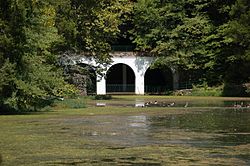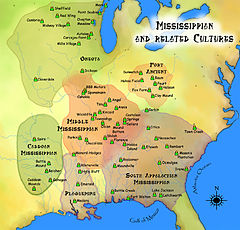- Dunbar Cave State Park
-
Dunbar Cave State Park 
Dunbar Cave State Park sceneType Tennessee State Park Location Clarksville, TN Coordinates 36°33′01″N 87°18′21″W / 36.5503°N 87.3059°WCoordinates: 36°33′01″N 87°18′21″W / 36.5503°N 87.3059°W Area 110 acres (0.45 km2) Operated by Tennessee Department of Environment and Conservation Status Cave tours have been suspended indefinitely in order to stop spread of White nose syndrome[1] Dunbar Cave State Park is a 110 acre (450,000 m²)[1] park in Clarksville, Tennessee, situated around Dunbar Cave. Dunbar Cave is the 280th largest cave complex in the world, stretching 8.067 miles (13 km) inward. In front of the cave entrance is a large concrete poured structure with three distinct arches. The cave is located in an area of karst topography, including sinkholes, springs, and limestone bedrock. The manmade Swan Lake also sits in front of the cave.[1] In March 2010 the cave was closed to tours and visitors because a bat infected with White nose syndrome was found in the cave.[2]
Contents
History
The entrance to Dunbar Cave was inhabited by local prehistoric peoples for thousands of years before settlers arrived. These peoples also left enigmatic drawings on the cave walls, perhaps as part of religious ceremonies. By 1790 it had been claimed by Isacc Rowe Peterson, who subsequently left the area in order to prepare his family to move there. During his absence Thomas Dunbar also claimed the area and settled his family there. Upon Petersons return a legal battle ensued, with legal title to the land going to Peterson in 1792, although the cave retained Dunbar's name.[3] During the Mexican-American War, the cave was used to mine saltpeter for gunpowder. In 1858, developers saw the potential in the area, along with nearby Idaho Springs, and the first cabins were built there. After the Civil War, the springs and the cave were acquired by J. A. Tate, who constructed a two-story hotel on the site.[4]
By 1931, the area had hosted numerous social events, including dances, concerts, and fairs, and was in need of repair and renovation. At the time, the state had just completed a new road in front of the hotel and an opportunity arose. A couple of local businessmen cleaned up the site, adding additional recreational facilities, including a concrete swimming pool, bathhouse, and tennis courts, and restoring and expanding the size of the hotel. The existing lake was also dammed up increasing its size to 20 acres (81,000 m²).[4]
Dunbar Cave was purchased by Roy Acuff on April 26, 1948 for $150,000. (Nashville Banner, April 27, 1948) The cave was the site of musical festivities and entertainment shows, which would host big bands like Benny Goodman's and Tommy Dorsey's. Acuff also added a golf course adjacent to the lake. Over time the popularity of the cave and surrounding area declined, and the hotel burned in 1950 and was not rebuilt.[4]
Dunbar Cave was purchased by McKay King in 1963. King operated the Dunbar Cave property until his death in 1971. The swiming pool was closed in 1967. The cave was inherited by his widow. (Matthews (2005), page 38.)
In 1973, the State of Tennessee, under then Governor Winfield Dunn, purchased Dunbar Cave from Mrs. McKay King, to become a State Natural Area.
In April of 1997 two young women were found dead in the area of the park. They had been abducted the day before from work at a Baskin Robbins ice cream shop. The accused murderer was Paul Dennis Reid who is awaiting execution on death row in Tennessee.
In 2002, the park shut down briefly during the state's budget cutting crisis.
Petroglyphs
On January 15, 2005 park specialist Amy Wallace, geologist and author Larry E. Matthews, local historian Billy Frank Morrison, and history professor Joe Douglas discovered Native American petroglyphs in Dunbar Cave.
The more than 30 drawings and etchings found in the cave were dated to the Mississippian era (700 to 1300 CE) using torches and other artifacts found nearby. Some of the pictographs are religious symbols, with one depicting a Mississippian supernatural warrior.[3] Their existence was announced to the public by the State of Tennessee on July 29, 2006, during the Second Annual Dunbar Cave Day, held at the Park.
2010 White Nose Syndrome shutdown
Although Dunbar Cave only has a small bat population, it is still closed from November to March to allow the bats undisrupted hibernation. In March 2010, a bat with White nose syndrome was discovered by researchers from Austin Peay State University doing assessments of species diversity and roosting patterns.[2] Based on finding the infected bat, the State of Tennessee announced on March 24, 2010 that Dunbar Cave was closed to all visitors and tours were discontinued. Since 2006 when the disease was first discovered in New York, it has spread to Ontario, New Jersey, New Hampshire, and Tennessee, causing the death of over a million bats. The US Fish & Wildlife Service (USFWS) has called for a moratorium on caving activities in the affected areas,[5] and strongly recommends that any clothing or equipment used in such areas be decontaminated after each use.
References
- ^ a b c "TN State Parks-Dunbar Cave State Park". http://www.state.tn.us/environment/parks/DunbarCave/index.shtml. Retrieved 2010-03-16.
- ^ a b Calabrese-Benton, Tisha. "Dunbar Cave State Park Suspends Cave Tours". http://news.tennesseeanytime.org/node/4804. Retrieved 2010-06-27.
- ^ a b Schroeder, Owen. "Dunbar Cave". http://www.theleafchronicle.com/article/99999999/ENTERTAINMENT/608270355/Dunbar-Cave. Retrieved 2010-06-28.
- ^ a b c Matthews, Larry E. (2005). Dunbar Cave: The Showplace of the South. National Speleological Society. ISBN 978-1879961227.
- ^ "USFWS-WNS-Cave-Advisory". U.S Fish and Wildlife Service. March 26, 2009. http://www.caves.org/WNS/USFWS-WNS_cave_advisory_news_rls_2009-03-26_final-1.pdf. Retrieved 2010-10-13.
Further reading
- "Indian Glyphs Discovered In Dunbar Cave, Tennessee" by Larry E. Matthews, NSS News, v. 64, no. 12, pp 10–12.
- "Ancient Cave Art at Dunbar Cave State Natural Area" by Jan F. Simek, Joseph C. Douglas, and Amy Wallace, Tennessee Conservationist Magazine, v. 73, no. 5, pp 24–26.
External links
- Dunbar Cave State Park
- The Friends of Dunbar Cave
- Tennessee Department of Environment and Convervation
 Mississippian and related cultures
Mississippian and related culturesMiddle Mississippian Adams Site · Angel Mounds · Angel Phase · Aztalan State Park · Beasley Mounds Site · Big Eddy Site · Boyd Mounds Site · Brentwood Library Site · Brick Church Mound and Village Site · Cahokia · Castalian Springs · Chucalissa · Cloverdale archaeological site · Dickson Mounds · Dunbar Cave · Fewkes Group Archaeological Site · John Roy Site · Kincaid Mounds · Kuhn Station Site · Marshall Site · Millstone Bluff · Mitchell Site · Monks Mound · Mound Bottom · Murphy Mound Archeological Site · Obion Mounds · Old Town Archaeological Site · Orendorf Site · Prather Site · Rowlandton Mound Site · Sellars Indian Mound · Shiloh Indian Mounds Site · Steed-Kisker culture · Sugarloaf Mound · Swallow Bluff Island Mounds · Tolu Site · Towosahgy · Turk Site · Twin Mounds Site · Wickliffe MoundsSouth Appalachian
MississippianBottle Creek Indian Mounds · Citico · Dauphin Island · Etowah · Fort Walton Culture · Fort Walton Mound · Garden Creek site · Hickory Ridge Cemetery · Hoojah Branch Site · Jere Shine Site · Lake Jackson Mounds · Leon-Jefferson Culture · Letchworth Mounds · Liddell Archeological Site · Moccasin Bend · Moundville · Muscogee (Creek) · Nacoochee Mound · Ocmulgee · Pisgah Phase · Roods Landing · Town Creek Indian Mound · Velda Mound · Waddells Mill Pond SitePlaquemine Mississippian Anna Site · Emerald Mound Site · Fitzhugh Mounds · Flowery Mound · Foster's Mound · Ghost Site Mounds · Grand Village of the Natchez · Holly Bluff Site · Jaketown Site · Julice Mound · Mangum Mound Site · Mazique Archeological Site · Medora Site · Mott Mounds · Pocahontas Mounds · Routh Mounds · Scott Place Mounds · Transylvania Mounds · Venable Mound · Winterville Site ·Caddoan Mississippian Battle Mound Site · Belcher Mound Site · Bluffton Mound · Caddoan Mounds · Gahagan Mounds · Ka-Do-Ha Indian Village · Spiro MoundsUpper Mississippian
culturesAlligator Effigy Mound · Beattie Park Mound Group · Blood Run Site · Clover Site · Dodge Site · Fort Ancient culture · Hartley Fort State Preserve · Leo Petroglyph · Oneota · Roche-a-Cri Petroglyphs · Serpent Mound · SunWatch Indian VillageLate Mississippian /
ProtohistoricAnhaica · Apalachee Province · Belle Meade Phase · Bussell Island · Caddo · Caborn-Welborn culture · Campbell Site · Chiaha · Citico · Coosa chiefdom · Dallas Phase · de Soto Expedition · Eaker Site · Hovey Lake · Joara · Jordan Mounds · Lamar Phase · Mabila · Menard-Hodges Site · Natchez · Nodena Phase · Parkin Site · Slack Farm · Taensa · Tipton Phase · Toqua (Tennessee) · Tunica · Walls PhaseLanguages Religion Ballgame · Black drink · Calumet (pipe) · Chunkey · Earth/fertility cult · Green Corn Ceremony · Horned Serpent · Long-nosed god maskette · Mississippian stone statuary · Platform mound · Shell gorget · Southeastern Ceremonial Complex · Thunderbird · Underwater pantherRelated topics · American Bottom · Chevron bead · Clarksdale bell · Maize · Mississippian culture pottery · Mill Creek chert · Stone box grave Pre-Columbian North America
Pre-Columbian North AmericaArchaeological cultures North American pre-Columbian chronology – Adena – Alachua – Ancient Pueblo (Anasazi) – Baytown – Belle Glade – Buttermilk Creek Complex – Caborn-Welborn – Calf Creek – Caloosahatchee – Clovis – Coles Creek – Deptford – Folsom – Fort Ancient – Fort Walton – Fremont – Glades – Glacial Kame – Hopewell (List of Hopewell sites) – Hohokam – Leon-Jefferson – Mississippian (List of Mississippian sites) – Mogollon – Monongahela – Old Cordilleran – Oneota – Paleo-Arctic – Paleo-Indians – Patayan – Plano – Plaquemine – Poverty Point – Prehistoric Southwest – Red Ocher – Santa Rosa-Swift Creek – St. Johns – Steed-Kisker – Tchefuncte – Tocobaga – Troyville
Archaeological sites Angel Mounds – Bandelier National Monument – The Bluff Point Stoneworks – Cahokia – Chaco Canyon – Casa Grande – Coso Rock Art District – Eaker – Effigy Mounds National Monument – Etowah Indian Mounds – Eva – Folsom Site – Fort Ancient – Fort Center – Gila Cliff Dwellings National Monument – Holly Bluff Site – Hopewell Culture National Historical Park – Kincaid Mounds – Kolomoki – Manitou Cliff Dwellings – Marksville – Meadowcroft Rockshelter – Mesa Verde – Moorehead Circle – Moundville – Mummy Cave – Nodena Site – Ocmulgee National Monument – Old Stone Fort – Parkin Park – Pinson Mounds – Portsmouth Earthworks – Poverty Point – Pueblo Bonito – Rock Eagle – Rock Hawk – Salmon Ruins – Serpent Mound – Spiro Mounds – SunWatch – Taos Pueblo – Toltec Mounds – Town Creek Indian Mound – WintervilleMiscellaneous Ballgame – Black drink – Buhl woman – Calumet – Chunkey – Clovis point – Container Revolution – Eastern Agricultural Complex – Eden point – Effigy mound – Falcon dancer – Folsom point – Green Corn Ceremony – Horned Serpent – Kennewick man – Kiva – Metallurgy – Mi'kmaq hieroglyphic writing – Medicine wheel – Mound builders – N.A.G.P.R.A. – Norse colonization of the Americas – Piasa – Pueblo dwellings – Southeastern Ceremonial Complex – Three Sisters agriculture – Thunderbird – Underwater panther
Categories:- Clarksville, Tennessee
- Tennessee state parks
- Caves of Tennessee
- Mississippian culture
- Native American history
- Protected areas of Montgomery County, Tennessee
- Show caves in the United States
Wikimedia Foundation. 2010.


